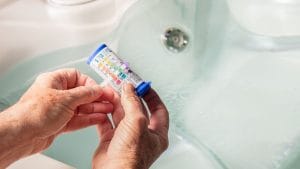
Hot tubs have become increasingly popular in the UK, providing homeowners with a luxurious and relaxing experience. Installing a hot tub in your home requires careful planning and consideration. In this guide, we will take you through the step-by-step process of hot tub installation for UK homes.
From selecting the right location to ensuring proper electrical connections, we will cover everything you need to know to enjoy the benefits of a hot tub in your own backyard.
Selecting the ideal location for your hot tub is essential for both convenience and aesthetics. Consider the following factors when choosing the spot:
Accessibility:
One of the key factors to consider when selecting the location for your hot tub is accessibility. You want to ensure that the hot tub is easily accessible for you and your guests while maintaining a sense of privacy. Consider placing it in a location that is easily reached from your home, such as a deck or patio area. This way, you can enjoy the convenience of having the hot tub close by without compromising on your privacy.
Level Ground:
Choosing a flat and stable surface is crucial for the proper installation and functioning of your hot tub. The ground on which you place your hot tub should be level and capable of supporting the weight of the tub, water, and its occupants. Uneven ground can lead to structural issues and affect the performance of the hot tub. Ensure that the surface is properly prepared and levelled before placing the tub on it.
Sun Exposure:
Consider sun exposure when determining the location for your hot tub. Maximizing sun exposure can enhance your enjoyment, as the warmth of the sun can add to the relaxation and comfort of soaking in the hot tub. Additionally, sunlight can help minimize debris accumulation by aiding in the evaporation of water and keeping the tub dry. However, it’s also important to strike a balance and provide some shade options, especially during hot summer days, to ensure you can comfortably use the hot tub without the sun becoming too intense.
Proximity to Utilities:
When possible, it’s beneficial to place the hot tub close to water and electrical sources. This proximity makes it easier to fill and drain the tub as well as connect it to the necessary power supply. Having a nearby water source simplifies the process of filling the tub, whether it’s through a hose connection or other means. Similarly, locating the hot tub near an electrical source ensures that you have a convenient and safe way to power the tub’s electrical components, such as pumps, heaters, and lighting systems. By considering the proximity to utilities, you can streamline the installation process and make maintenance tasks more accessible.
By taking these factors into account when selecting the location for your hot tub, you can ensure both convenience and an aesthetically pleasing setup that enhances your overall hot tub experience in your UK home.
Before installing the hot tub, you need to prepare the site properly. Follow these steps:
Clear the Area:
Begin by clearing the area where you intend to install the hot tub. Remove any obstacles, debris, or vegetation that might be present in the chosen location. This includes rocks, tree branches, plants, and any other items that could potentially obstruct the installation process or pose a safety hazard. Clearing the area will provide a clean and secure space for the hot tub.
Measure and Mark:
Accurately measuring the dimensions of the hot tub is essential for proper placement and alignment. Use a measuring tape to measure the length, width, and height of the hot tub. Once you have these measurements, mark the outline of the hot tub on the ground or surface where it will be installed. This will give you a clear visual reference and help ensure that the hot tub fits perfectly in the designated space.
Excavation:
In some cases, you may need to excavate the site or create a suitable foundation for the hot tub. This step is particularly important if you are installing an in-ground or partially submerged hot tub. If excavation is required, carefully dig a hole following the marked outline. Ensure that the depth and dimensions of the hole are appropriate for the size of the hot tub. It is crucial to maintain the integrity of the surrounding area while excavating and to create a level base for the hot tub to rest on.
If your hot tub is above-ground or portable, excavation may not be necessary. However, it is still essential to prepare the site by ensuring the ground is level and free from any bumps or unevenness. Use a levelling tool to ensure that the surface is flat and stable, providing a solid foundation for the hot tub.
By following these steps to prepare the site, you will create an optimal environment for the hot tub installation. Clearing the area, accurately measuring and marking the dimensions, and, if needed, excavating the site will help ensure a secure and level foundation for your hot tub, allowing you to enjoy it safely and comfortably in your UK home.
It is crucial to ensure that the area can support the weight of the hot tub and its occupants. Consider the following:
Structural Integrity:
Before placing the hot tub, it is essential to check the stability and integrity of the ground or surface where it will be installed. Examine the soil or the structure underneath to ensure it can adequately support the weight of the hot tub and its occupants. Look for any signs of sinking, erosion, or instability that may compromise the installation. If you notice any issues, address them before proceeding with the installation to prevent future problems.
Load-Bearing Capacity:
Determine whether the deck or surface where you plan to install the hot tub can handle the weight it will exert. Hot tubs can be heavy, especially when filled with water and occupied by people. Check the load-bearing capacity of the deck or surface to ensure it meets or exceeds the weight requirements specified by the hot tub manufacturer. If in doubt, consult a structural engineer or a professional contractor to assess the load-bearing capacity and determine if any reinforcements or modifications are necessary.
Professional Consultation:
If you have any concerns about the structural integrity or load-bearing capacity of the area, it is highly recommended to seek advice from a qualified structural engineer or a professional contractor. They can assess the site, evaluate the existing structure, and provide expert guidance on whether additional support or modifications are required. Consulting with professionals will help ensure that your hot tub installation is safe, secure, and in compliance with the necessary structural requirements.
By considering the structural requirements, checking the stability of the ground or surface, assessing the load-bearing capacity, and seeking professional consultation when needed, you can have peace of mind knowing that your hot tub installation is structurally sound and can withstand the weight and usage over time. Taking these precautions will help ensure the longevity and safety of your hot tub installation in your UK home.
Proper electrical connections are vital to the safe and efficient operation of your hot tub. Follow these guidelines:
Hire a Qualified Electrician:
It is crucial to engage the services of a qualified electrician who specializes in hot tub installations. Installing the necessary electrical components requires expertise and knowledge of local building codes and safety regulations. A qualified electrician will ensure that the electrical work is done correctly, minimizing the risk of electrical hazards and ensuring compliance with the necessary standards.
Electrical Supply:
To power your hot tub, you need to ensure that you have an appropriate electrical supply that meets the specific requirements of your hot tub model. The electrical supply must be able to provide the necessary voltage and current to operate the hot tub’s equipment, such as pumps, heaters, and controls. Consult the manufacturer’s specifications or consult with your electrician to determine the electrical supply requirements for your hot tub.
When it comes to electrical connections, it is essential to prioritize safety and compliance. Hiring a qualified electrician will ensure that the electrical components are installed correctly, reducing the risk of electrical issues and ensuring the safe operation of your hot tub. By providing an appropriate electrical supply and incorporating a GFCI into the system, you can enjoy your hot tub with peace of mind, knowing that the electrical setup is secure and in line with safety standards.
Please note that electrical regulations and standards may vary depending on your location, so it’s always best to consult with a professional electrician familiar with the specific requirements in your UK area. An electrician will always verify the correct requirements for your needs.
Water supply and drainage play a crucial role in hot tub installation. Here’s what you should know:
Water Source:
Determine the nearest water source for filling your hot tub. This could be an outdoor tap or a hose connection. Assess the distance between the hot tub and the water source to ensure that you have enough hose length or piping to reach the tub easily. Additionally, check the water quality in your area to ensure it is suitable for use in your hot tub. If needed, consider using a water filtration or treatment system to maintain the water’s cleanliness and clarity.
Drainage System:
Plan for proper drainage to empty and maintain your hot tub effectively. You will need a drainage system that allows you to remove and dispose of the water safely and efficiently. Ensure that the drainage area is designed to handle the volume of water from your hot tub. It should have appropriate drainage channels or a floor drain that can handle the water flow. Consider the location of the drainage system to avoid water pooling or causing any damage to your property.
Consideration for Freeze Protection:
If you live in an area with frequent freezing temperatures, it is crucial to take steps to protect your hot tub and plumbing from potential freeze damage. Freezing temperatures can cause water to expand and damage pipes, pumps, and other components. Consider installing freeze protection measures such as insulation, heat tape, or a freeze control system. These measures can help prevent freezing and ensure that your hot tub remains operational during colder months.
By determining a suitable water source, planning for proper drainage, and considering freeze protection measures, you can effectively manage the water supply and drainage aspects of your hot tub installation. Proper water management ensures that you can fill and empty your hot tub easily and maintain its longevity, while also taking into account the specific considerations needed for your UK location.
Installing a hot tub is an important step in the process, and it’s typically best to have it done by your hot tub supplier. Reputable suppliers, such as Hot Tub Doctors in Blackpool, often offer installation services without any extra charge. However, if you have a specific reason to prefer self-installation, the following steps outline the basic procedure:
Follow the Manufacturer’s Instructions:
Carefully read and adhere to the installation guidelines provided by the hot tub manufacturer. The manufacturer’s instructions are specific to the model you have purchased and will provide detailed guidance on the installation process. Following these instructions ensures that the hot tub is installed correctly and helps maintain warranty coverage.
Positioning the Tub:
Place the hot tub onto the prepared surface, ensuring that it is level. Carefully position the hot tub according to the dimensions and outline that you previously measured and marked. It’s crucial to ensure that the tub is level to prevent any water imbalance or stress on the structure. Use a levelling tool to ensure accuracy, making any necessary adjustments to achieve a level position.
Connecting Utilities:
Connect the electrical and plumbing components of the hot tub as per the manufacturer’s instructions. This typically involves connecting the electrical supply, such as wiring the hot tub to a dedicated circuit, and plumbing connections for water circulation. It is important to follow the manufacturer’s instructions precisely to ensure proper functionality and safety. If you are unsure about any aspect of the electrical or plumbing connections, it is advisable to seek professional assistance from an electrician or plumber experienced in hot tub installations.
It is worth noting that while self-installation is an option, it is generally recommended to have a professional installer handle the installation process. They have the expertise and knowledge to ensure that the hot tub is installed correctly, minimizing the risk of errors or issues that could affect the performance and safety of the hot tub.
By carefully following the manufacturer’s instructions, positioning the hot tub correctly, and connecting the utilities as per guidelines, you can ensure a proper and successful hot tub installation. Whether you choose professional installation or decide on self-installation, prioritizing accuracy and adherence to instructions will help ensure a smooth and efficient installation process.
After the hot tub installation is complete, it’s essential to conduct regular testing and establish a maintenance routine to keep your hot tub in optimal condition. Consider the following factors:
Water Balance and Chemistry:
Regularly test the water balance and chemistry of your hot tub to ensure it remains clean and safe for use. Test the pH levels, alkalinity, and sanitizer levels using appropriate testing kits or strips. Adjust the chemical levels as needed to maintain the recommended balance. This helps prevent issues such as bacterial growth, scaling, or cloudiness in the water. Additionally, it’s important to regularly shock or sanitize the water to keep it fresh and clear.
Filtration and Cleaning:
Maintaining clean water is crucial, and proper filtration plays a significant role in achieving this. Clean or replace the filters regularly to ensure they effectively remove debris and contaminants from the water. Follow the manufacturer’s guidelines for cleaning and replacing filters. Additionally, establish a cleaning schedule for the tub’s surfaces. Wipe down the interior and exterior surfaces, remove any debris, and pay attention to hard-to-reach areas. This regular cleaning routine helps keep the hot tub hygienic and appealing.
Regular Inspections:
Perform routine inspections to check for any potential issues or damage. Look for leaks, both around the tub and in the plumbing connections. Inspect the electrical components for any signs of wear or malfunction. Pay attention to the jets, valves, and other equipment, ensuring they are working correctly. By conducting regular inspections, you can identify and address any problems promptly, minimizing the risk of larger issues and ensuring the long-term functionality of your hot tub.
Establishing a maintenance routine is crucial to keep your hot tub in excellent condition and ensure a pleasant and safe experience. Regularly testing and adjusting the water chemistry, cleaning or replacing filters, and conducting routine inspections will help maintain water quality, prolong the life of your hot tub, and minimize potential issues.
Remember to refer to the manufacturer’s guidelines and recommendations for specific maintenance procedures and intervals. Following these guidelines will help you effectively care for your hot tub and enjoy it for years to come in your UK home.
Safety should be a top priority when using a hot tub. Implementing the following safety measures will help ensure the well-being of everyone enjoying the hot tub:
Secure Cover:
Install a locking cover on your hot tub to prevent unauthorized access, especially when the tub is not in use. A secure cover acts as a barrier, preventing children, pets, or any other individuals from entering the hot tub without supervision. Make sure the cover is properly secured and meets safety standards. This not only protects against accidents but also helps to retain heat and keep debris out of the water.
Safety Signs:
Display clear and visible signs near the hot tub area that provide guidelines and safety precautions. These signs can include reminders to shower before entering the tub, to avoid using the hot tub while under the influence of alcohol or drugs, and to limit the maximum occupancy. Additionally, you can include instructions on how to use the hot tub safely, such as avoiding running or diving into the tub, keeping electrical devices away from the water, and monitoring children closely. The signs should be easy to read and understand to ensure everyone’s awareness of the safety guidelines.
By implementing these safety measures, you can create a safer environment for hot tub users and minimize the risk of accidents or injuries. Installing a secure cover prevents unauthorized access, displaying safety signs promotes awareness of safety guidelines, and maintaining GFCI protection ensures electrical safety. These measures work together to provide a secure and enjoyable hot tub experience for everyone in your UK home.
Remember to regularly review and reinforce these safety measures, communicate the guidelines to all hot tub users, and promote responsible use of the hot tub to maintain a safe and enjoyable environment.
Enhancing the visual appeal of your hot tub area can greatly contribute to creating a relaxing and inviting atmosphere. Consider the following landscaping and aesthetic options to elevate your hot tub experience:
Privacy:
To create a private and tranquil space around your hot tub, consider installing fencing, screens, or vegetation. This helps to block views from neighbouring properties or public areas, providing a sense of seclusion and intimacy. Bamboo screens, tall plants, or strategically placed trellises can offer privacy while still allowing airflow and natural light. Additionally, consider incorporating decorative elements such as outdoor curtains or privacy panels to enhance the privacy and aesthetic appeal of the area.
Lighting:
Incorporating outdoor lighting not only adds to the overall ambience of the hot tub area but also enhances safety during nighttime use. Install a combination of task lighting, such as wall-mounted lights or post lights, and accent lighting, such as string lights or solar-powered pathway lights. These lighting fixtures can create a warm and inviting atmosphere while ensuring visibility and preventing accidents. Choose lighting options that are waterproof and suitable for outdoor use.
Surroundings:
Create a relaxing atmosphere around your hot tub by enhancing the surroundings with plants, furniture, and accessories. Choose plants that thrive in outdoor environments and provide a sense of serenity, such as potted palms, ferns, or colourful flowers. Incorporate comfortable outdoor furniture, such as loungers or seating sets, that allows you and your guests to relax before or after using the hot tub. Consider adding accessories like waterproof cushions, outdoor rugs, or decorative pillows to enhance comfort and style. Additionally, you can install shelving or storage units to keep essentials such as towels, drinks, or spa accessories within easy reach.
By focusing on landscaping and aesthetics, you can create a visually appealing and inviting hot tub area that complements your UK home. Privacy features like fencing or vegetation offer a sense of seclusion, while well-placed lighting adds ambience and ensures safety. Enhancing the surroundings with plants, comfortable furniture, and accessories creates a relaxing and enjoyable space for you and your guests to unwind.
Take into consideration your personal style and preferences when selecting landscaping elements and accessories, ensuring they harmonize with the overall aesthetic of your outdoor space. By creating an attractive and comfortable environment, you’ll further enhance your hot tub experience.
Installing a hot tub in your UK home can elevate your relaxation and provide a soothing retreat right in your own backyard. By following the steps outlined in this guide, you can ensure a successful installation process. Remember to prioritize safety, adhere to manufacturer instructions, and establish a regular maintenance routine to keep your hot tub in optimal condition for years to come.
Q1: Do I need planning permission to install a hot tub in my UK home?
A1: In most cases, hot tubs are considered “permitted developments” and do not require planning permission. However, it’s recommended to check with your local authorities to confirm any specific regulations or restrictions.
Q2: Can I install a hot tub on my existing deck?
A2: It depends on the deck’s structural integrity and load-bearing capacity. Consult with a structural engineer to assess if your deck can support the weight of the hot tub.
Q3: How often should I clean the hot tub filters?
A3: The frequency of cleaning the filters depends on usage and manufacturer recommendations. Generally, it’s advisable to clean or replace the filters every 1 to 3 months.
Q4: Can I move a hot tub after installation?
A4: While it is possible to move a hot tub, it can be challenging and may require professional assistance. It’s recommended to plan the location carefully during the installation process.
Q5: Are there any specific safety precautions I should take with a hot tub?
A5: Yes, some safety precautions include installing a locking cover, displaying safety signs, maintaining GFCI protection, and regularly inspecting the tub for any issues or damage.




Our newsletter will let you know about special offers, coupons and seasonal tips and advice.


Unit 4B, Fox Ind Estate, Holyoake Ave, Blackpool FY2 0QX
Copyright © 2023, Hot Tub Doctors. Design By Matty England Website Services